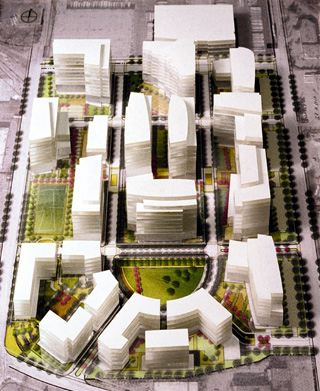
Surveys
DJC.COM
December 7, 2007
Will good times continue for our market?
Wright Runstad & Co.

Johnson
|
As we approach the end of 2007, the year will go in the books as one of the best for this region’s commercial real estate markets. Strong job growth fueled rent increases, and investors paid handsome premiums to own Puget Sound properties.
Our markets might be poised for another great year in 2008, if not for some unsettling macroeconomic conditions. What effect they will have cannot be predicted, but it’s clear that the turmoil in the capital markets caused by the subprime lending debacle, falling home values caused by the nationwide housing oversupply, escalating prices for food and fuel, and the potential for a pullback in consumer spending will not support a strong national economy.

Image courtesy of Wright Runstad & Co. Future growth will be centered on transportation infrastructure nodes, such as those included in Bellevue’s Spring District proposed by Wright Runstad & Co. and Shorenstein Properties. |
We are fortunate that the Puget Sound region’s economy has a lot going for it, with a diverse mix of company headquarters, such as Amazon.com, Boeing, Microsoft and Nordstrom. High-wage employers such as Google, Yahoo and other growing companies have targeted the region for expansion. In the second half of 2007, a variety of industries experienced job growth, including a 6.2 percent jump in information services, a 4.5 percent rise in professional and technical services, and a 3.7 percent increase in manufacturing.
The University of Washington, a global leader in research, attracts some of the brightest minds to Seattle. In addition, our region’s natural beauty, urban energy and high quality of life have attracted a pool of talented and creative people to staff our growing companies.
Is it no surprise, then, that the Urban Land Institute and PricewaterhouseCoopers’ “Emerging Trends in Real Estate 2008” ranked Seattle as the country’s strongest market for industrial, office and apartment investment, and second best for hotel and retail. Seattle, the report states, is one of the country’s “preeminent global gateways, the nation’s commercial and cultural wellsprings in a rapidly integrating world economy.”
Times are good.
Reconciling opposing forces
There is no doubt that we are enjoying a surge in commercial real estate market fundamentals. In downtown Seattle, demand for office space has grown, buoyed by a 3.5 percent increase in office-based jobs over the past year. As a result, by the end of the third quarter, the office vacancy rate, at 8.93 percent, was the lowest it has been since 2001. As vacancy rates have decreased, average Class A lease rates in Seattle have risen nearly $7.50 per square foot from the first quarter to a third-quarter rate of $34.42.
In downtown Bellevue, the news is even more positive. The vacancy rate in the CBD dropped to 8.90 percent — also the lowest since 2001 — and the average Class A lease rates are at a whopping $37.24 per square foot. This rise over Seattle could be due in part to the fact Seattle has 38 million square feet of office space compared to downtown Bellevue’s less than 7 million square feet.
It’s easy to be optimistic when you hear such numbers, but what happens when the national slowdown arrives in the Puget Sound region? Everyone in our business knows that our region’s economy has run in 10-year cycles, and each and every cycle has ended with a thud.
And then there’s our traffic. The Emerging Trends synopsis of Seattle is succinct: “Abysmal traffic congestion strangles commuters, with no relief in sight.”
2008 and beyond
Optimists say we can expect more of the same for our region in 2008. Jobs and population are expected to increase by 2.7 percent and 1.7 percent, respectively — both strong indicators for continued growth in the local commercial real estate market. Still, it may not be enough to sustain the recent pace of the market.
The softer market may not catch up with us in 2008, but it will eventually. And when it does, our region’s transportation problems — and more importantly our lack of plans to improve our infrastructure — will make things more difficult.
We strongly believe that we need to get on track quickly to add transportation capacity. Planning for our region’s future growth must continue, and we all know that land-use and transportation infrastructure are linked in multiple ways. Compact, dense development in nodes linked to the region’s existing and future infrastructure is one of the smartest ways to accommodate growth.
The city of Bellevue recognizes this and is in the process of finalizing its long-range land-use and transportation vision for the Bel-Red corridor based on smart growth principles. This is an important reason why a joint venture of Wright Runstad & Co. and Shorenstein Properties is preparing to move forward with the first phase of The Spring District, a major sustainable development in the Bel-Red corridor.
The Spring District will occupy a 36-acre site near the intersection of two of our region’s major highways: state Route 520 and Interstate 405. The development eventually will have more than 3 million square feet of office space, up to 1,000 multifamily units and ground-floor retail space. Its pedestrian, bicycle, vehicular and mass-transit connections will give its occupants a range of transportation choices.
As more tenants and building owners come to understand the benefits of compact, mixed-use development patterns that support transit, we can expect to see an increase in these smart-growth patterned complexes. Benefits are both tangible (lower operating costs and increased employee productivity) and intangible (environmental stewardship and corporate responsibility image).
For 35 years, Wright Runstad & Co. has weathered the ups and downs of the market, navigating through the ever-changing times. Where we all stand this time next year remains to be seen, but we are very optimistic about our region’s future and we will continue to make major investments in high-quality projects.
Greg Johnson is president of Wright Runstad & Co., a commercial real estate development and operating company with more than 3 million square feet of space under development, including more than 1 million square feet under construction.
Other Stories:
- Commercial real estate continues its strength
- Retail evolves in mixed-use projects
- Use cost segregation to cut Uncle Sam’s bite
- Too many condos in Seattle? Think again
- An urban village emerges on Seattle’s First Hill
- Pros and cons of the Industrial Jobs Initiative
- What’s next for Seattle’s CBD office market?
- Developing retail? Here are some things to know
- Downtown becomes too pricey for disabled homeless
- Workforce housing shortage is a ‘silent epidemic’
- Now is the time for apartments — but beware!
- Full speed ahead as CBA turns 30
- CBA Insights speaker profile: Dennis Wilde
- CBA Insights speaker profile: John Parker
- CBA Insights speaker profile: Linda Berman
- Hot Eastside office market won’t get red hot
Copyright ©2009 Seattle Daily Journal and DJC.COM.
Comments? Questions? Contact us.